Baby Flat Head
Baby flathead happens when a baby’s skull becomes flattened or deformed due to forces acting on the skull. There are two main types of baby flathead:
Brachycephaly:
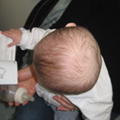 The infant’s head is flat on the back part of the skull. This occurs if your baby spends a lot of time on their back.
The infant’s head is flat on the back part of the skull. This occurs if your baby spends a lot of time on their back.
Plagiocephaly:
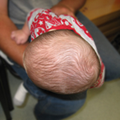 The infant’s head is flat on one side. This occurs if the baby tends to keep their neck turned to one side.
The infant’s head is flat on one side. This occurs if the baby tends to keep their neck turned to one side.
What Causes Baby Flathead?

A baby is most at risk to develop a flat head in the first four months of life. A newborn baby’s skull bones are soft and thin to allow for easier passage through the birth canal. This makes the skull of a young baby more moldable. In addition to this, a younger baby is not yet strong enough to roll or change their position on their own.
If your baby prefers to look in one direction or spends most of the time on his or her back, this can cause it too.
In the 1990’s the American Academy of Pediatrics and the Canadian Pediatric Society launched the “The Back to Sleep” campaign to reduce the incidence of Sudden Infant Death Syndrome (SIDS). While the incidence of SIDS has decreased significantly, babies are spending more time on their backs and are more likely to develop flathead.
While baby flathead does not affect the development of the baby’s brain it can affect the baby’s appearance.
How to Prevent Baby Flathead
Give your baby tummy time
 Baby’s should get a total of least 30 minutes of supervised tummy time a day from the time they are sent home from the hospital unless otherwise instructed by your doctor. Your baby should be awake for tummy time.
Baby’s should get a total of least 30 minutes of supervised tummy time a day from the time they are sent home from the hospital unless otherwise instructed by your doctor. Your baby should be awake for tummy time.
Tummy time is important as it helps to strengthen the baby’s neck and upper body.
It is common for babies to cry when they are on their tummy. Here is a list of tips to help your baby tolerate tummy time:
- Lie your baby on your chest;
- have lots of interesting things for your baby to look at when on their tummy; or
- place a small roll under your baby’s chest and prop their arms in front of the roll.
Alternate your baby’s head position when they are sleeping
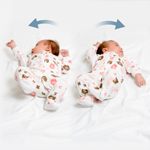 The Canadian Pediatric Society recommends that infants sleep on their back at night time. To help prevent baby flathead, simply try to alternate your baby’s head position each time they go to sleep. Turn their neck to the left for one sleep and the next time turn the neck to the right.
The Canadian Pediatric Society recommends that infants sleep on their back at night time. To help prevent baby flathead, simply try to alternate your baby’s head position each time they go to sleep. Turn their neck to the left for one sleep and the next time turn the neck to the right.
If your baby wakes frequently throughout the night alternate their head position each time they go back to sleep.
 Limit the amount of time that your baby spends in equipment
Limit the amount of time that your baby spends in equipment
Extended use of equipment such as car seats, swings, and bouncy chairs can contribute to flathead as the baby’s head is resting on a hard surface. Limit the use of such equipment to when only necessary.
Ensure your baby can turn their neck fully in both directions
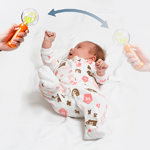
It is common for young babies to prefer to look in one direction when they are lying on their backs. If you notice this with your baby, try to encourage them to look to the less preferred side by using brightly colored toys or your face. This will help to strengthen the muscles on that side.
If your baby is unable to turn their neck to both sides you should discuss this with your doctor or community health nurse, as your baby may have a condition known as Torticollis.
My Baby Has a Flat Spot
If your baby develops a flat spot, the shape of the baby’s head can be changed by using specific repositioning techniques. Positioning is most effective when it is started early. The positioning takes the pressure off of the flat spot so your baby’s head can round out as the head grows.
For babies with a flat spot on one side:
- Position them slightly off their back to the opposite side at about a 45 degree angle for all *supervised sleep.
- A roll can be used behind and in front of the baby to help keep them in that position.
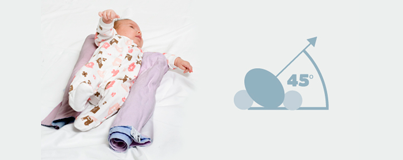
Babies with a flat spot on the back of their heads:
- Position them fully on their sides for *supervised sleep.
- Alternate the side they are on each time they sleep.
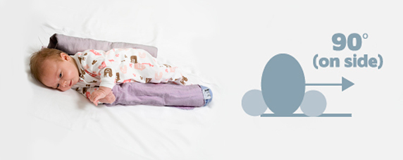
*Supervised sleep means anytime the baby is asleep and you are awake and monitoring your baby.
The earlier the positioning is started the better chance that the baby’s head shape will improve.
There is typically a natural improvement to the head shape after this time. If the baby’s head shape has not improved by five months of age they may require helmet therapy.